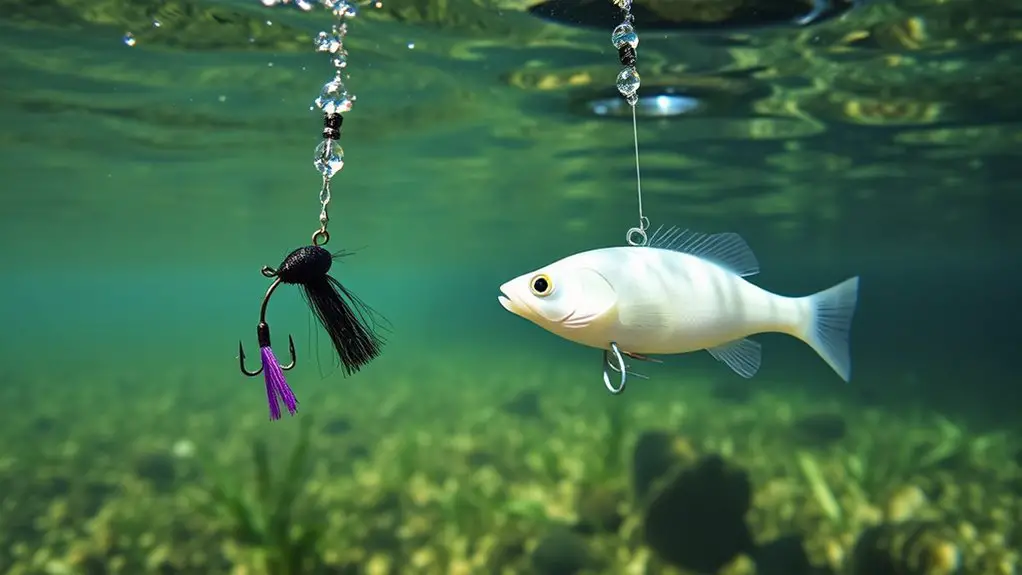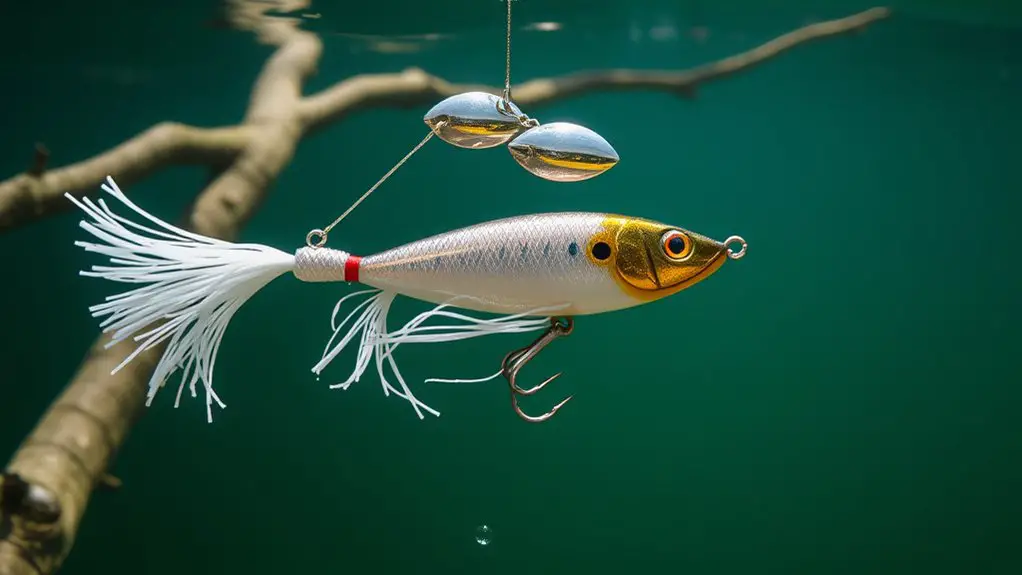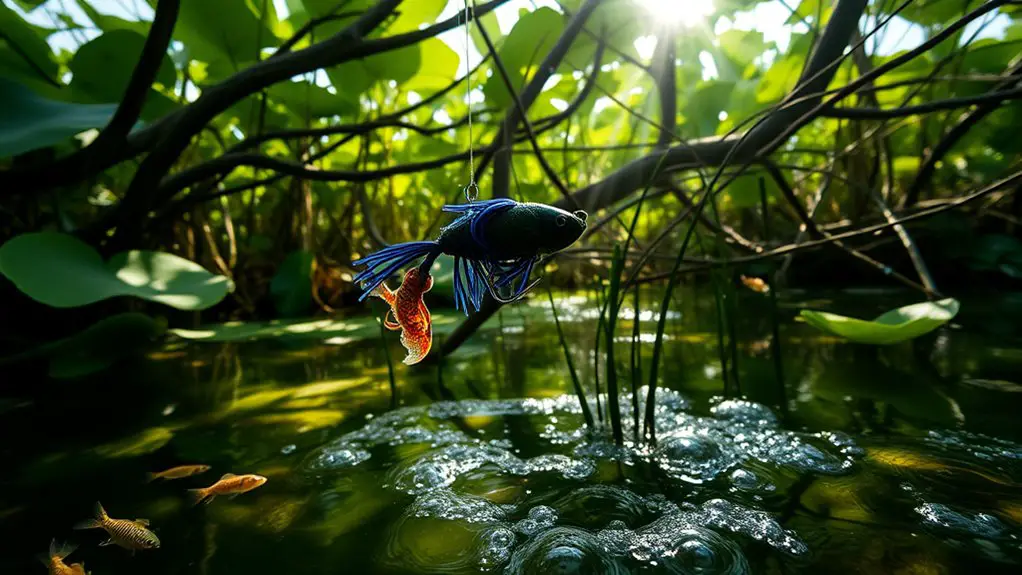The most effective bass lures include crankbaits (accounting for 28% of catches), versatile soft plastics like Senkos, and reaction-triggering spinnerbaits. Match your lure to water conditions—natural colors for clear water, bold hues for murky situations. Seasonally, use jerkbaits in spring, topwater lures during summer mornings, and slow-retrieved jigs in fall/winter. Remember to fish during low-light periods when bass feed actively, and always approach larger specimens quietly. These fundamentals will transform your next fishing trip.
Surf Fishing Highlights
- Crankbaits account for 28% of bass catches and excel during fall, with erratic deflections triggering reaction strikes.
- Soft plastic baits dominate tournaments (60% of catches) with versatile rigging options like Texas, wacky, or weightless.
- Match lure colors to water clarity—natural tones in clear water, bold colors in murky conditions.
- Topwater lures produce explosive strikes in shallow water during low-light periods or overcast days.
- The Yamamoto Senko offers beginners versatility while finesse techniques with lighter tackle excel in pressured waters.
Understanding Bass Behavior: The Foundation of Lure Selection
Shadows and secrets—that’s the world of bass fishing. To select the right lure, you’ll need to understand how these elusive predators actually behave.
Beneath the surface lies a calculated game of deception—knowing the bass mind means wielding the right lure.
Bass aren’t random wanderers; they’re creatures of habit with surprisingly small home ranges (under 60 acres annually).
They’re shade-seekers, avoiding bright sunlight while preferring ambush points near structural edges and vegetation.
Your timing matters too—fish actively feed during low-light conditions and follow biological clocks that trigger feeding windows lasting about two hours. During seasonal transitions, bass follow established migratory routes![]() along features like roadbeds and tree lines as they move between deep and shallow waters.
along features like roadbeds and tree lines as they move between deep and shallow waters.
The larger, trophy-sized bass over 20 inches tend to be more easily disturbed and react to noise![]() from boats and other fishing activities, making stealth a critical component of your approach.
from boats and other fishing activities, making stealth a critical component of your approach.
During summer months, bass typically relocate to deeper, cooler waters![]() where oxygen levels remain more stable and comfortable for their metabolism.
where oxygen levels remain more stable and comfortable for their metabolism.
Hard Baits That Drive Bass Wild: Crankbaits and Spinnerbaits
While the fish move stealthily through their underwater homes, your arsenal of hard baits stands ready to trigger their predatory instincts.
Crankbaits excel at provoking reaction strikes, accounting for nearly 28% of bass catches across all seasons. Fall fishing particularly benefits from these versatile lures, with 45% of fall bass![]() caught on crankbaits. You’ll want to match your crankbait’s diving depth to where bass are holding, and don’t shy away from crashing them into cover—that erratic deflection often triggers the most explosive bites! Select a crankbait with teardrop shape
caught on crankbaits. You’ll want to match your crankbait’s diving depth to where bass are holding, and don’t shy away from crashing them into cover—that erratic deflection often triggers the most explosive bites! Select a crankbait with teardrop shape![]() to maximize its distinctive wobbling action that bass find irresistible.
to maximize its distinctive wobbling action that bass find irresistible.
Spinnerbaits shine in stained water, where their flash and vibration call bass from a distance. Crankbaits become particularly deadly when presented in optimal temperatures![]() when bass are actively hunting for prey. They’re cover-friendly workhorses that let you efficiently probe vegetation and rocks where lunkers lurk, waiting to ambush your lure.
when bass are actively hunting for prey. They’re cover-friendly workhorses that let you efficiently probe vegetation and rocks where lunkers lurk, waiting to ambush your lure.
Soft Plastic Essentials: Why Every Bass Angler Needs These
Soft plastic baits form the backbone of any serious bass angler’s tackle box, accounting for more than 60% of all bass caught in tournaments nationwide.
Their versatility is unmatched—rig them weightless, wacky, Texas-style, or on a jighead to adapt to any fishing scenario you’ll encounter.
Your essential arsenal should include stick worms (perfect for wacky rigging), creature baits (those appendages drive bass crazy!), and soft jerkbaits that mimic wounded baitfish.
Don’t forget tubes for smallmouth and crawfish imitations for those bottom-dwellers.
The beauty? You can fish them slow in pressured waters or work them aggressively when bass are feeding.
For beginners overwhelmed by choices, focusing on just four basic types![]() of soft plastics can simplify selection while maintaining effectiveness.
of soft plastics can simplify selection while maintaining effectiveness.
They’re practically bass candy!
The Yamamoto Senko stands out as a highly recommended starting point with its versatile fishing options![]() for beginners looking to master soft plastics techniques.
for beginners looking to master soft plastics techniques.
Ribbon tail worms are incredibly effective at various depths, making them a fantastic cleanup bait![]() when fish have missed other lures.
when fish have missed other lures.
Matching Lures to Water Conditions: Clarity and Depth Considerations

When you cast your lure into a lake or river, the water’s clarity and depth dramatically impact your success more than any other environmental factor.
Understanding these conditions is your secret weapon!
Mastering water clarity and depth isn’t just an advantage—it’s the ultimate edge in your fishing arsenal.
In clear water (visibility >8 feet), stick with natural colors like green pumpkin or translucent patterns.
As visibility decreases, adjust accordingly—chartreuse and orange shine in stained water, while black and red create striking silhouettes in muddy conditions.
Depth matters too.
Shallow areas (<5 feet) call for topwater presentations, mid-depths (5-15 feet) favor crankbaits and spinnerbaits, while deeper zones need heavy jigs or deep-divers.
For shallow topwater fishing, target grass beds or lily pads![]() with specialized frog lures for exciting strikes from larger bass.
with specialized frog lures for exciting strikes from larger bass.
In water with green algae tints, choose darker colored lures like purple and black to create strong contrast![]() against the green backdrop.
against the green backdrop.
In dirty water with visibility under 2 feet, add rattles to your lures to help bass detect your bait![]() through their sensitive lateral line when they can’t rely on eyesight.
through their sensitive lateral line when they can’t rely on eyesight.
Seasonal Strategies: How to Adapt Your Lure Selection Throughout the Year
Beyond water clarity and depth, the seasonal calendar shapes your bass fishing strategy more than any other factor.
Bass behavior transforms dramatically as water temperatures shift, requiring you to adjust your tackle box accordingly.
- Spring: Start with suspending jerkbaits during pre-spawn (8-15 feet), then switch to soft plastic stickbaits and floating lizards when bass guard their beds in shallow water. During post-spawn, bass will actively chase topwater baits
 as they return to aggressive feeding patterns. Shad and crawfish-related colors are particularly effective in late spring
as they return to aggressive feeding patterns. Shad and crawfish-related colors are particularly effective in late spring as bass transition to their summer patterns. For optimal success during spawning season, fish mid-morning when bass are most active
as bass transition to their summer patterns. For optimal success during spawning season, fish mid-morning when bass are most active protecting their nests.
protecting their nests. - Summer: Deploy topwater lures in morning hours, then change to deep diving crankbaits when bass retreat to cooler depths.
- Fall/Winter: Match the slowing metabolism with darker jigs and soft plastics, retrieving s-l-o-w-l-y for those lethargic cold-water strikes.
Finesse Fishing Techniques: When Subtlety Outperforms Power
The delicate art of finesse fishing stands in stark contrast to the bold, aggressive techniques many bass anglers default to when hitting the water.
You’ll need lighter tackle, smaller lures, and a slower approach when bass turn finicky.
Your best results come during high-pressure situations—clear water, heavily fished lakes, or those post-frontal doldrums when bass seem to have lockjaw.
Try jig worms, Neko rigs, or small tube baits on lightweight jigheads. For optimal results, consider fishing the wacky rig![]() around vegetation, boathouses, and rocky areas to entice hesitant bass with its unique falling action. Utilizing a drop shot rig
around vegetation, boathouses, and rocky areas to entice hesitant bass with its unique falling action. Utilizing a drop shot rig![]() near weed beds and structures creates realistic presentations that passive bass find irresistible. Top professional tournament anglers now routinely carry spinning rods
near weed beds and structures creates realistic presentations that passive bass find irresistible. Top professional tournament anglers now routinely carry spinning rods![]() as essential equipment rather than just backup options.
as essential equipment rather than just backup options.
Your 4-8 pound test line, paired with a sensitive spinning setup, becomes your secret weapon when those trophy bass have “seen it all” before.
Reaction Baits: Triggering Aggressive Strikes When Bass Aren’t Hungry

Unlike traditional lures that rely on a bass’s hunger, reaction baits exploit something far more primal—the instinctive predatory response.
Bass fishing’s secret weapon—triggering strikes through instinct, not appetite.
When bass won’t commit to feeding, these lures can still trigger explosive strikes by mimicking wounded prey.
Three keys to reaction bait success:
- Match retrieval to conditions—faster in warm water, more pauses in cold
- Focus on low-light periods when bass position higher in the water column
- Create erratic movements—the “jerk-jerk-pause” cadence with jerkbaits is particularly deadly
You’ll find spinnerbaits, walking topwaters, and chatterbaits shine when water clarity exceeds 3 feet.
For optimal results, prioritize making sudden presentations by flipping jigs![]() or worms into heavy cover where bass are likely to ambush their prey.
or worms into heavy cover where bass are likely to ambush their prey.
As fishing pressure increases during tournaments, be prepared to switch from reaction baits to bottom presentations![]() when fish become more hesitant to strike moving lures.
when fish become more hesitant to strike moving lures.
Topwater Tactics: Creating Surface Commotion for Explosive Strikes
Nothing compares to the heart-stopping thrill of a bass exploding through the water’s surface to attack your lure.
For best results, focus on water depths under 5 feet, especially during dawn, dusk, or overcast days when bass are naturally more active near the surface.
Your lure selection should match conditions: poppers for calm water, buzzbaits for stained water, and walking baits for that irresistible “wounded baitfish” action.
Remember, nearly 90% of strikes happen within the first 6 feet of retrieve, so make those long casts count!
Keep your lure moving after a missed strike—stationary lures look suspiciously like sticks to wary bass.
Deep Water Mastery: Lures That Reach Bass in Their Comfort Zone
When bass retreat to deeper water during midday heat or seasonal patterns, you’ll need specialized lures that can effectively reach these underwater sanctuaries. Drop shot rigs shine in depths of 17-100+ feet, maintaining subtle vibration that tempts finicky fish without spooking them.
- Football jigs mimic crawfish and sculpins perfectly, maintaining stable bottom contact in rocky terrain while allowing you to work ledges and drop-offs.
- Flutter spoons imitate dying baitfish—cast beyond structure, let fall, then rip upward 4-5 feet repeatedly.
- Swimbaits (4-6 inch paddle tails) on heavy jig heads create irresistible rolling action when retrieved slowly after counting down to proper depth.
Heavy Cover Fishing: Lures That Penetrate the Thickest Bass Hideouts

Bass love to hunker down in the densest, most impenetrable cover they can find, creating a serious challenge for even seasoned anglers.
You’ll need specialized weaponry for these fortress-like hideouts.
Hollow-bodied frogs skip beautifully across vegetation mats, while heavy flipping jigs (¾-1 oz) muscle through laydowns.
Don’t overlook Texas-rigged creature baits with tungsten weights—they’re cover-punching champions!
For vibration that bass can’t resist, chatterbaits and buzzbaits excel when thick stuff blocks visibility.
The Right Equipment: Pairing Your Lures With Proper Rods and Lines
For ideal bass fishing success:
- Pair medium-heavy, fast-action rods (6’6″-7′) with jigs and pitching techniques for quick hooksets.
- Choose moderate-action rods for crankbaits, allowing fish more time to take the bait.
- Match your line strength to your cover—fluorocarbon (10-12lb) for clear water, braided (30lb+) when battling vegetation.
You’ll feel the difference immediately when your setup clicks!
Color Selection: When to Go Natural vs. When to Go Bold
The subtle art of color selection can make the difference between a trophy bass and an empty livewell. Your choice should adapt to water conditions—not personal preference.
In clear water, stick with natural tones (browns, pearls, and chromes) that mimic local prey without spooking wary bass.
When visibility drops in murky or stained waters, reach for your bold arsenal—chartreuse, fluorescent yellows, and oranges—to create contrast that bass can’t miss.
Frequently Asked Questions
How Long Do Quality Bass Lures Typically Last Before Needing Replacement?
Your quality bass lures will last quite differently based on type.
Hard baits like crankbaits can serve you faithfully for 3-5 years (or longer!) if you’re treating them right.
Soft plastics without flavor additives might give you 1-3 seasons of solid action, while those scented varieties lose their mojo within months.
Watch for telltale signs—brittleness in plastics, faded colors, or bent hooks mean it’s time to refresh your tackle box.
Proper storage is your lure’s best friend!
Can I Modify Store-Bought Lures to Increase Their Effectiveness?
Yes, you can absolutely modify store-bought lures for better results!
Drill holes for rattles, bend buzzbait arms for vibration—small tweaks yield big returns. You’ll find painting frog legs black or adding tinsel to spinnerbaits mimics baitfish more realistically.
Don’t hesitate to add trailer hooks to reduce missed strikes or apply scent gels for a natural look. The best anglers aren’t just buying lures—they’re customizing them!
Just remember, gentle modifications preserve function while boosting effectiveness.
Are More Expensive Bass Lures Worth the Investment?
Expensive bass lures can be worth it in specific situations.
You’ll find premium options like Megabass jerkbaits truly shine in clear water or when bass are finicky. The improved materials and action sometimes justify the price tag, especially for tournament anglers.
However, don’t fall for marketing hype! Many mid-priced lures perform just as well with minor modifications.
Consider your fishing conditions, frequency, and budget before splurging. Remember, it’s often the angler’s skill—not the lure’s price tag—that fills the livewell.
How Should I Properly Store Bass Lures Between Fishing Trips?
Store your bass lures in a cool, dry place away from direct sunlight.
You’ll want to use plastic tackle boxes with adjustable dividers for hardbaits, while keeping soft plastics in their original packaging (or resealable bags) to prevent melting or color bleeding.
Don’t mix different plastic types together—they can have an unfortunate “chemical conversation” that ruins both!
For hooks and terminal tackle, use small waterproof containers to prevent rust between your trophy-catching adventures.
Which Lures Work Best for Night Fishing for Bass?
When darkness falls, your tackle box should shine with these night fishing champions.
Black-colored spinnerbaits with Colorado blades work wonders, as their thumping vibration acts like a dinner bell for bass.
You’ll also want topwater lures like Jitterbugs or buzzbaits that create noticeable disturbance.
Don’t forget large soft plastic worms in dark colors (black, blue, or june bug) for slow presentations near cover.
Bass rely on lateral line detection after dark, so lures creating strong vibration are your midnight allies.
Conclusion
You’ve now explored the art of bass fishing from shallow to deep, soft plastics to hard cranks. Whether you’re casting in gin-clear lakes or murky swamps, your tackle box should reflect these diverse conditions. Remember, sometimes that subtle natural shad imitator will outfish the flashiest chartreuse spinner. Your success depends on this balancing act—matching lure to environment, season to technique. With these strategies in your arsenal, you’re ready to hook that trophy bass waiting beneath the surface.

